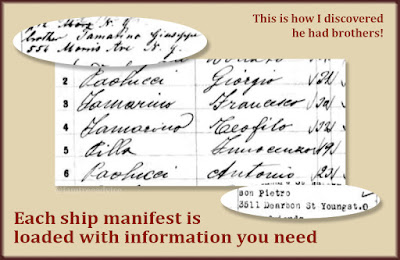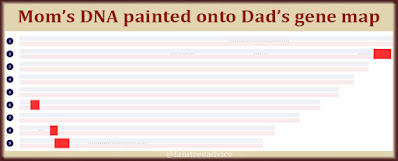Think a 45-minute drive to work is pretty good? Your ancestors would be shocked.
I visited the town of Hornell, New York, in 2016. I walked back and forth in front of the house where my grandmother Lucy was born.
Then I walked in front of the train station (now the Hornell Erie Depot Museum) where my great grandfather Pasquale worked. Although I drove, Pasquale's house was less than a half mile from the railroad yard.
 |
| What was your ancestor's workday routine like? |
Bing Maps says it's a 7-minute walk to work. I can imagine Pasquale walking home for lunch. His wife Maria Rosa would have his place at the table set and waiting for him. He could eat for a few minutes and walk back to work. I don't know how long his lunch break was, but he could definitely do this within 30 minutes.
One great resource for learning where your male ancestor lived and worked is his draft registration card.
- If he was born between 1872 and 1900 and lived in America, you should be able to find his World War I draft registration card.
- If he was born between 28 April 1877 and 16 February 1897 and lived in America, you should be able to find his World War II draft registration card. These are not the cards for young men who were to be drafted. This was the "Old Man's Draft" to be used only in an emergency situation.
 |
| I wasn't sure of the company name until I Googled it. |
A draft registration card can tell you the name and address of the business where your ancestor worked. The cards also have your ancestor's home address.
You can easily create a "commuter graphic" for each ancestor:
- Go to your favorite map software such as Bing Maps or Google Maps.
- Enter his work address.
- Click the Directions button and select walking directions to his job location.
- Save this walking map and the directions with a screen capture tool such as Windows Snipping Tool.
- Add the commuting map to your ancestor's profile in your family tree software.
You can also Google the business name and address to find out more about the company. In 1918, Harold Patrick Gibbons worked for Schorsch & Company. I discovered they were a paper bag manufacturer that had moved to the Bronx, New York, in 1913. Their street address changed over time, but their building was the same until they went out of business in 1951. Harold had a 7-minute walk to work, just like my great grandfather.
 |
| When you see how close your ancestor lived to work, you might rethink your choices. |
Also in 1918, Giuseppe Golia lived north of New York City in the town of Port Chester. His World War I draft registration card says he worked in Port Chester for "R.B.&W." A Google search found that the Russell, Burdsall & Ward Bolt and Nut Company is still in business, but not in Port Chester. Founded in 1844, the company started the Port Chester Bolt and Nut Company in Port Chester in 1871. They became the Russell, Burdsall & Ward Bolt and Nut Company, where Giuseppe Golia worked, in 1901.
I don't have a street address for RB&W, but it's a safe bet they were along the railroad tracks. Giuseppe's 1918 address doesn't exist anymore. But his 1920 address is a 6-minute walk to the railroad tracks.
 |
| If you don't have the exact address, you can make an educated guess. |
These commuter graphics give you another insight into your ancestor's daily life. I imagine my ancestors would think my commute is as wonderful as I do. But I can't map it online. My commute is from my bedroom to my great room.
How far did your ancestors commute to work?















